ABS AUDI A3 2012 Owner´s Manual
[x] Cancel search | Manufacturer: AUDI, Model Year: 2012, Model line: A3, Model: AUDI A3 2012Pages: 280, PDF Size: 70.11 MB
Page 139 of 280

Other things that can affect Advanced
Airbag performance
Changing the vehicle's suspension system can
change the way that the Advanced Airbag Sys
tem performs in a crash. For example, us ing
tire-r im combinations not approved by Aud i,
lowering the vehicle, changing the stiffness of
the suspension, including the springs, suspen sion struts, shock absorbers etc. can change
the forces that are measured by the a irbag
se nsors and sent to the electron ic control
u ni t. Some suspens ion changes c an, for exam
p le, increase the force levels measured by the
sensors and make the airbag system deploy in
crashes in w hic h it would not dep loy if the
changes had not been made. Other k inds of
changes may reduce the force levels meas
ured by the sensors and prevent the airbag
from deploying when it shou ld .
The sensors in the safety belt buckle for the
driver and front passenger seat tell the elec
tronic control module if the safety belt is
l atched or not. If the safety belt is being used,
the front airbag will deploy at a slightly high
e r rate of vehicl e deceleration than if the safe
ty belt is not being used. Therefore, in a par
ticular co llision, it is poss ible th at an a irbag
will not deploy at a seating position where the
safety be lt is bei ng used but will inflate at the
position whe re the safety belt is not being
used. It is important that nothing interfere
with the safety belt buckles so t hat the sen
sors can send the correct information about
safety belt use to the electron ic cont rol unit.
A WARNING
Cha nging the vehicle's s uspension inclu d
ing use of u napproved t ire-rim comb ina
ti ons can change Advan ced A irb ag pe r
formance and incre ase the risk of ser io us
personal in jury in a crash.
- Never ins tall suspe nsion compone nts
t h at d o not h ave the same per forman ce
characteristics as the components origi
nally installed on you r vehicle .
- Never use t ire-r im combinat ions that
have not bee n approved by A udi.
A irba g sy stem 13 7
A WARNING
Items stored between the safety be lt
buckle and the center console can cause
the sensors in the b uckle to send the
wrong informa tion to the e lectronic con
trol module a nd prevent t he A dvan ced Air
bag System from wo rking properly.
- Always ma ke sure t ha t nothing can inter
fe re wi th the safety belt buckles and that
t hey are not obs truc te d .
Side airbags
Description of side airbags
The airbag system can provide supplemental
protection to properly restrained occupants.
Fi g. 135 Side a irbag location in t he drive r's seat
The side airbags are located in the sides of the
front seat backrests~
fig. 135 and the rear
back rest* facing the doors . Th ey are id entified
by the wo rd "AIRBAG".
The side airbag sy stem basically consi st s of :
-the electron ic control modu le and external
side impact sensors
- the two side airbags located in the s ides of
the front backrests
- two rear side airbags (as an ordered
option)
- t he airbag warn ing light in the ins trument
cl uste r.
T he airbag system is mo nitored e lec tronically
t o m ake ce rtain tha t it is fu nction ing p ro perl y
at all times . Each time you turn on the ig ni
tion, the airbag system indicator light will
come on for a few seconds (self diagnostics) . ..,.
Page 164 of 280
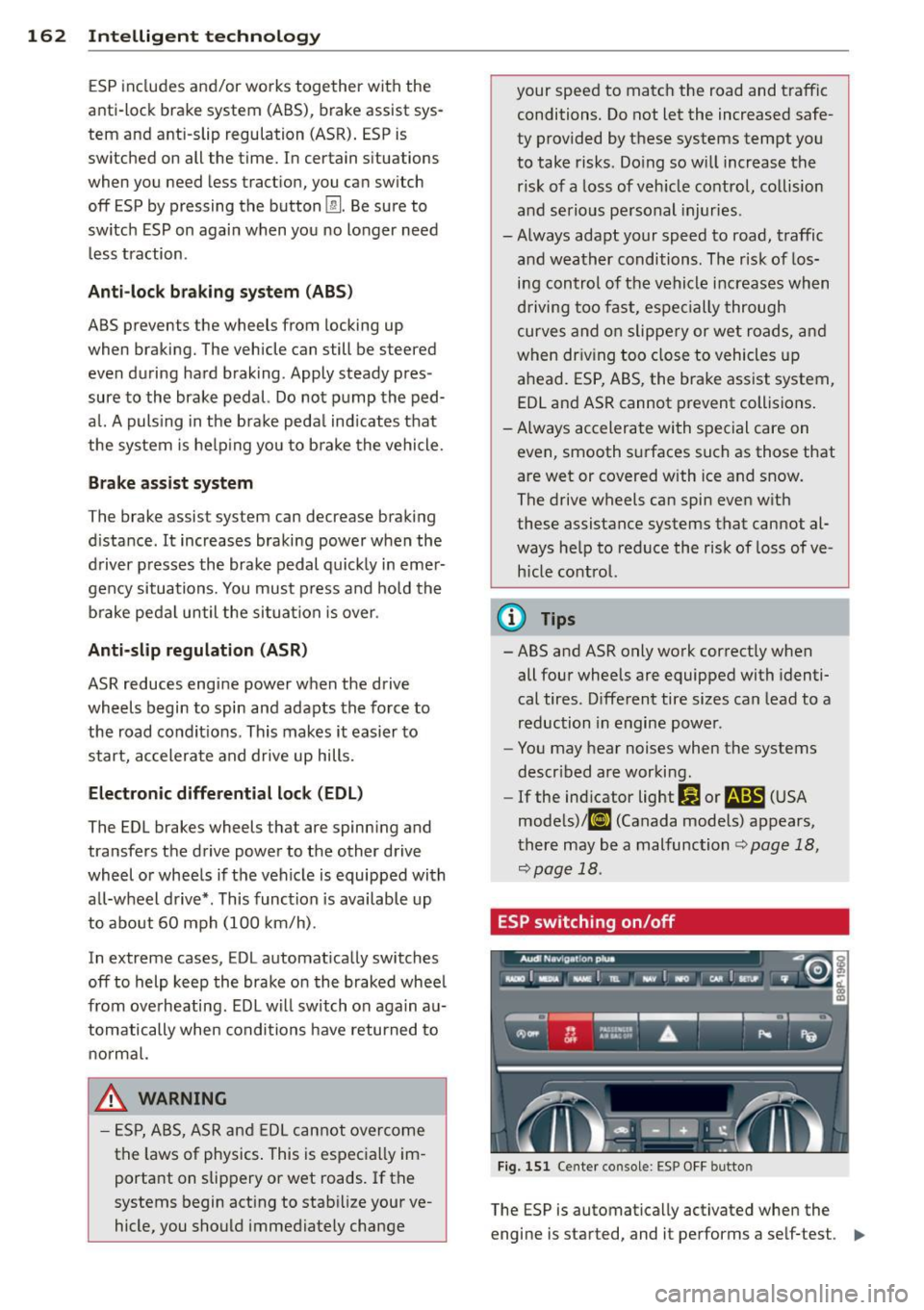
162 Intelligent technology
ESP includes and/or works together with the
anti-lock brake system (ABS), brake assist sys
tem and anti-slip regulation (ASR). ESP is
switched on all the time. In certain situations
when you need less tract ion, you ca n sw itch
off ESP by pressing the button [g] _ Be sure to
switch ESP on again when you no longer need l ess traction .
Anti-lock b raking system (ABS)
ABS prevents the wheels from locking up
when braking. The vehicle can still be steered
even during hard braking. Apply steady pres
sure to the brake pedal. Do not pump the ped
al. A puls ing in the b rake pedal ind icates that
the system is he lp ing you to b ra ke the vehicle.
Br ake a ssist system
The brake assist system can decrease braking
d istance. It increases braking power when the
d river presses the brake pedal quick ly in eme r
gency situations. You must press and hold the
brake peda l until the si tuation is over .
Anti-slip regulation (ASR)
ASR reduces engine power when the drive
wheels begin to spin and adapts the fo rce to
the road co ndit io ns. This makes it easier to
start, ac celerate and drive up hills.
Electronic differential loc k (EDL )
The EDL brakes wheels that are spinn ing and
transfers the drive power to the other drive
wheel or whee ls if the vehicle is equipped with
a ll-wheel d rive*. This funct ion is available up
to abo ut 60 mph (100 km/h).
In extreme cases, EDL automat ically switches
off to help keep the brake on the braked whee l
from ove rheating . EDL w il l switch on aga in au
tomatically when conditions have returned to
n o rmal.
& WARNING
- ESP, A BS, ASR an d EDL cannot ove rcome
the laws of physics . This is espec ially im
portant on slippery or wet roads. If the
systems begin act ing to stab ilize your ve
hicle, you should immediately cha nge your speed to matc
h the road and t raffic
conditions. Do not let the increased safe
ty provided by these systems tempt you
to take risks. Do ing so w ill increase the
ris k of a loss of veh icle control , co llision
and serious pe rsonal inj uries .
- Always adapt your speed to road, traffic and weather conditions. The risk of los
ing control of the vehicle inc reases when
d riving too fast, espec ially through
curves and on slippe ry or wet roads, and
when dr iv ing too close to vehicles up
ahead. ESP, ABS, the brake assist system, EDL an d ASR cannot prevent collisions.
- Always accelera te with special care on
even, smooth s urfaces such as those that
are wet or covered with ice and snow.
The drive wheels can spin even w ith
these assistance systems that cannot al
ways he lp to red uce the risk of loss of ve
h icle control.
(D Tips
- ABS and ASR only work correct ly when
all four wheels are equipped with identi
cal tires. Diffe rent tire sizes can lead to a
reduction in engine powe r.
- You may hear noises when the systems
descr ibed are working .
- If the indicator light
D] or m (USA
mode ls)/ KC] (Canada models) appears,
t here may be a malfunction~
page 18,
~page 18.
ESP switching on/off
Fig. 151 Ce nter conso le: ESP O FF butto n
The ESP is automat ically activated whe n the
engine is started, and it performs a se lf-test .
II>
Page 166 of 280
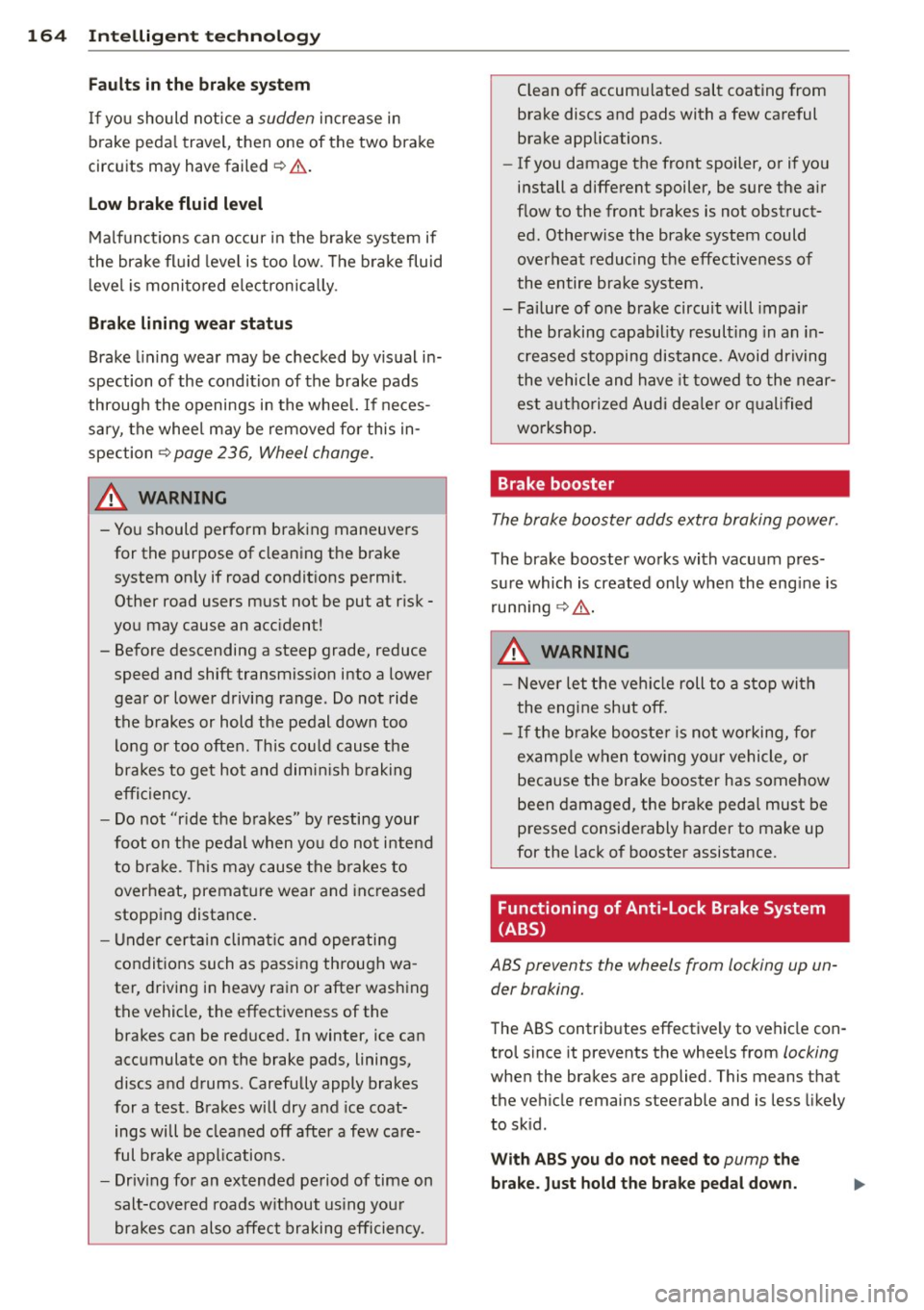
164 Intelligent technolog y
Faults in the bra ke sys tem
If you should notice a sudden increase in
b rake peda l travel, then one of the two brake
circuits may have failed¢.& .
Low brake flu id le vel
Malfunct ions can occur in the brake system if
the brake fluid level is too low . T he brake fluid
l eve l is moni to red electronica lly .
Bra ke lining w ear st atu s
Brake l ining wear may be checked by visual in
spection of the condition of the brake pads
through the openings in the whee l. If neces
sa ry, the wheel may be removed for this in
spection
¢page 236, Wheel change.
A WARNING
-You should perform braking maneuvers
for the purpose of cleaning the brake
system on ly if road conditions permit.
Other road users must not be put at risk -
you may cause an acc ident!
- Before descending a steep grade, reduce
speed and shift transmiss ion into a lower
gear or lower driving range . Do not ride
the brakes or hold the pedal down too long or too often. This cou ld cause the
brakes to get hot and dimin ish braking
efficiency.
- Do not "r ide the brakes" by resting your
foot on the pedal when yo u do not intend
to bra ke . This may cause the brakes to
overheat, premature wear and increased
stopping distance .
- Under certain climat ic and operating
condit ions such as passing through wa
ter, driving in heavy rain or after washing
the vehicle, the effectiveness of the brakes can be reduced. In winter, ice can
accumulate on the brake pads, linings,
discs and drums . Carefully apply brakes
for a test . Brakes will dry and ice coat
ings will be cleaned off after a few care
ful brake applications.
- Driv ing for an extended period of time on
salt-covered roads w ithout us ing your
brakes can also affect braking efficiency . Clean off accumulated salt coating from
brake discs and pads with a few careful
brake applications.
- If you damage the front spoiler, or if you
install a different spoiler, be sure the a ir
flow to the front brakes is not obstruct ed. Otherwise the brake system could
overheat reducing the effectiveness of
the entire brake system.
- Failure of one brake circuit will impa ir
the braking capab ility result ing in an in
creased stopping distance. Avoid driving
the vehicle and have it towed to the near
est a utho rized Audi dea le r or q ualified
wo rkshop.
Brake booster '
The brake booster adds extra broking power.
The brake booster works with vacuum pres
sure which is created only when the eng ine is
run ning ¢.&_ .
_&. WARNING
-Never let the vehicle roll to a stop with
the engine shut off.
- I f the b rake booster is not working, for
examp le when towing yo ur vehicle, or
because the brake booster has somehow
been damaged, the brake pedal must be
pressed conside rably harder to make up
for the lack of booster assistance.
Functioning of Anti-Lock Brake System
(ABS)
ABS prevents the wheels from locking up un der broking.
.
The ABS contributes effectively to vehicle con
trol since it prevents the whee ls from
locking
when the brakes are applied. This means that
the vehicle remains steerable and is less likely
to sk id .
With ABS you do not need to pump th e
brake. Ju st hold the b ra ke pedal down.
Page 167 of 280

However, do not expect that the ABS shortens
braking distance under
all circumstances.
When driving on grave l or on newly fallen
snow on top of icy surfaces, braking distance may be even longer, therefore, under these
circumstances, it is especially important that
you dr ive slowly and with great care .
How th e ABS syste m work s
An automatic check is made when a speed of
about 4 mph (6 km/h) is reached. When this
happens, a pumping noise can be heard .
If an individua l wheel begins to rotate too
slowly in relation to vehicle speed and tends
to lock, the ABS automatically reduces brake
pressure to prevent that wheel from locking.
This automatic adjustment process will cause
a
s light vib ration of the brake pedal and some
noises to alert you that vehicle speed must be
adapted to existing road and traff ic condi
tions .
A WARNING
Although the ABS is very effective, always
remember that bra king capability is limit
ed by t ire traction. Always adjust your dr iv
ing speed according to the road and traffic
conditions . Do not let the extra sa fe ty af
forded bytheABStemptyou into taking
extra r isks. The ABS cannot overcome the
laws of physics.
(D Tips
- If ABS is not functioning properly, a
warning light will come on. See
¢ page 18.
- If a fault occurs in the ABS, the EDL is al
so not functioning . This is indicated by
the ABS warning light.
Brake assistant
The broke assistant is designed to achieve the
optimum broking effect .
The brake assistan t helps to increase the ef
fective
b raking power and thus to achieve a
shorter stopping distance . If the driver
Int ellig ent technolog y 165
presses the brake peda l very quick ly, the brake
assistant automatically boosts the braking
force to the max imum level, up to the po int
where the anti-lock brake function (ABS) inter
venes to stop the whee ls from locking. You
shou ld then keep the brake peda l pressed un
t il the vehicle has braked to the required
speed. The brake assistant switches itself off
as soon as you release the b ra ke peda l.
The brake ass istant wi ll not be operative if
there is a ma lfunction in the ABS.
A WARNING
P lease remember that the acc ident risk a l
ways increases if you drive too fast, espe
cially in corners or on a slippe ry road, o r if
you follow the vehicle ahead of yo u too
closely . An increased accident risk cannot
be compensated even by the brake assis
tant, so always mainta in a safe speed.
Electro-mechanical
power assist
The electro-mechanical power assist helps
the driver when steering .
The degree of power assist is electronically
matched to vehicle speed .
The power steering system assists the driver
so that he can steer the vehicle with reduced physical effort.
Power steering will not work if t he engine is
off . As a result, the steering wheel will be hard
to turn .
A WARNING
If the system deve lops a problem, you
must seek qualified professiona l assis
tance.
(D Note
If there is an e lectronic malfunction, ser
votronic
will still function like a conven-
tiona l power steering system, providing a
constant steering support force that is no
-
l onge r proportionate to the vehicle speed. ..,.
•
•
Page 176 of 280
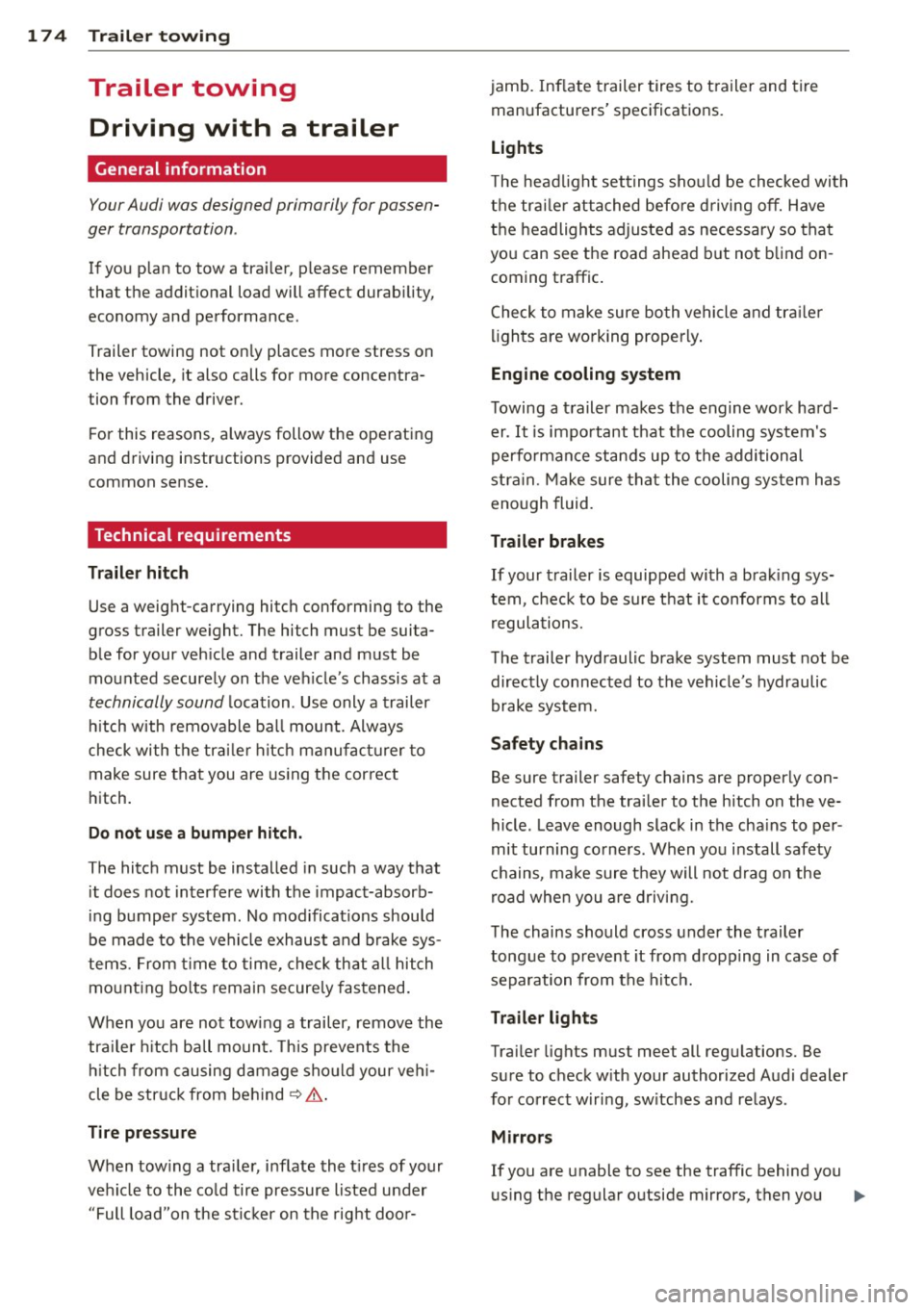
174 Trailer towing
Trailer towing Driving with a trailer
General information
Your Audi was designed primarily for passen
ger transportation .
If you plan to tow a tra iler, p lease remember
that the addit ional load will affect durability,
economy and performance.
T railer towing not on ly places more stress on
the vehicle, it also calls for more concentra
tion from the driver.
F or this reasons, always follow the operating
and drivi ng in str uctions provided and use
common sense.
Technical requirements
Traile r hitch
Use a weight-carrying hitch conforming to the
gross trailer weight. The hitch must be suita
b le for your veh icle and trailer and must be
mounted securely on the ve hicle's chassis at a
technically sound location. Use only a trailer
h itch with removable ba ll mount. Always
check with the tr ailer hitch manufac turer to
make sure tha t you are using t he cor rect
hitch.
Do not us e a bumper hitch .
The hitch must be installed in such a way that
it does not interfere with the impact-absorb
ing bumper syst em. No modifications should
be made to the vehi cle exhaust and brake sys
tems. From time to time, check th at a ll hitch
mo unt ing bo lts remain securely fastened.
When you are not towing a trailer, remove the
tra iler hitch ball mount. This prevents the
h itch from causing damage sho uld your ve hi
cle be str uck from behind
¢ A .
Tire pressure
When tow ing a traile r, inflate the t ires of your
ve hicle to the co ld tire pressure listed under
"Full load"on the stick er on the rig ht doo r- jamb. Inflate trailer tires to trailer and tire
manufacturers' specifications.
Lights
T he headlight set tings sho uld be checked with
t h e trai le r attached before d riving o ff. Have
the headlights adjusted as necessary so tha t
yo u can see t he road ahead b ut not blind on
coming traffic.
Check to make sure bo th ve hicle and tr ailer
lights are wo rk ing properly .
Engine cooling system
T owing a t railer makes the engine work hard
er.
It i s impo rtant that the cooling system's
performance stands up to the additional
stra in. Make sure tha t the cooling sys tem has
enough fluid.
Trailer brakes
If your trailer is equipped with a brak ing sys
tem, c heck to be sure t hat it conforms to all
regula tions.
The trailer hyd raulic brake system must not be
directly connected to the vehicle's hydraulic
brake system.
Safety ch ains
Be sure trailer safety chains are properly con
nected from the trailer to the hitch on the ve
hicle. Leave enough slack in the cha ins to per
mit turning co rne rs. When yo u in stall safety
c h ains, ma ke sure they will not drag on the
r oad when you a re driving.
The chains should cross under the t railer
tong ue to prevent it from dropping in case of
separation from the h itch.
Trailer lights
Trai ler lights must meet all regulations. Be
sure to check w ith your authorized Audi dealer
for correct w ir in g, sw itches and re lays .
Mir rors
If you are unable to see the traffic behind you
us ing the regular outside mirrors, then you
Page 178 of 280
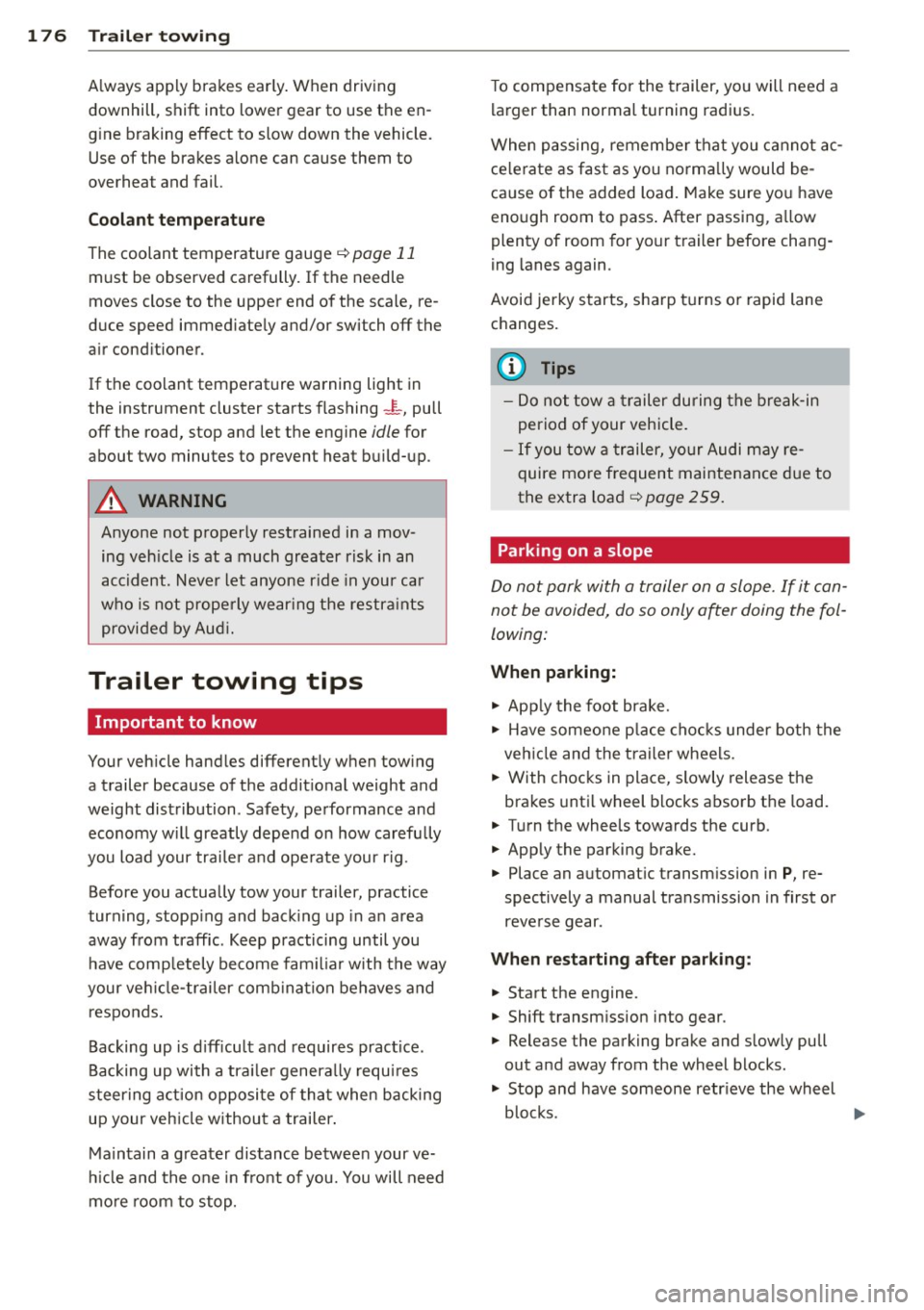
176 Trailer towing
Always app ly bra kes early . When driving
downhill, shift into lower gear to use the en
g ine braking effect to slow down the vehicle.
Use of the brakes alone can cause them to
overheat and fail.
Coolant temperature
The coolant temperature gauge ¢ page 11
must be observed carefully. If the needle
moves close to the upper end of the scale, re
duce speed immed iate ly and/or switch
off the
a ir cond itioner.
If the coolant temperature warning light in
the instrument cluster starts flashing
J_, pull
off the road, stop and let the engine idle for
about two minutes to prevent heat build-up.
A WARNING
Anyone not properly restrained in a mov
ing veh icle is at a much greater risk in an
accident . Never let anyone r ide in your car
who is not prope rly wear ing the restra ints
provided by Aud i.
Trailer towing tips
Important to know
Your veh icle handles different ly when towing
-
a trailer because of the addit io nal weight and
weight distribution . Safety, performance and
economy w ill greatly depend on how carefu lly
you load your trai ler and ope rate your rig .
Before you actually tow your trailer, practice
turn ing, stopp ing and back ing up in an area
away from traffic. Keep practicing until you have comp letely become fam iliar w ith the way
your ve hicle-trai ler comb ination behaves and
responds .
Backing up is d iff icu lt and requires practice .
Backing up with a tra ile r genera lly requ ires
steer ing act ion opposite of tha t when backing
up your veh icle without a trailer .
Ma intain a g reater distance between your ve
h icle and the one in fro nt of you. You will need
mo re room to stop. To compensate for the trailer, yo
u will need a
larger than normal turning radius.
When passing, remember that you cannot ac
ce le rate as fas t as you no rma lly would be
cause of the added load. Make sure yo u have
enough room to pass . After passing, a llow
plenty of room for your trailer before chang
ing lanes again.
Avoid jerky starts , sharp turns or rapid lane
changes.
(D Tips
- Do not tow a trailer during the break -in
period of your vehicle.
- If you tow a trailer, yo ur Audi may re
quire more frequent maintenance due to
the extra load ¢
page 2 59.
Parking on a slope
Do not park with a trailer on a slope . If it can
not be avoided, do so only after doing the fol
lowing:
When parking:
.,. App ly the foot brake.
.. Have someone p lace cho cks under both the
veh icle and the trailer wheels.
.. With chocks in place, slowly release the
brakes unti l wheel b locks absorb th e load.
.. Turn the whee ls towards the cu rb.
.. App ly the parking brake.
.. Place an automat ic transm ission in
P, re
spectively a manual transmission in first or
reverse gear .
When restarting after p ark ing:
.. Start the engine.
.. Shift transm ission into gear .
.. Release the parking brake and slowly pull
out and away from the wheel blocks.
.,. Stop and have someone retr ieve the wheel
b locks .
Ill-
Page 186 of 280
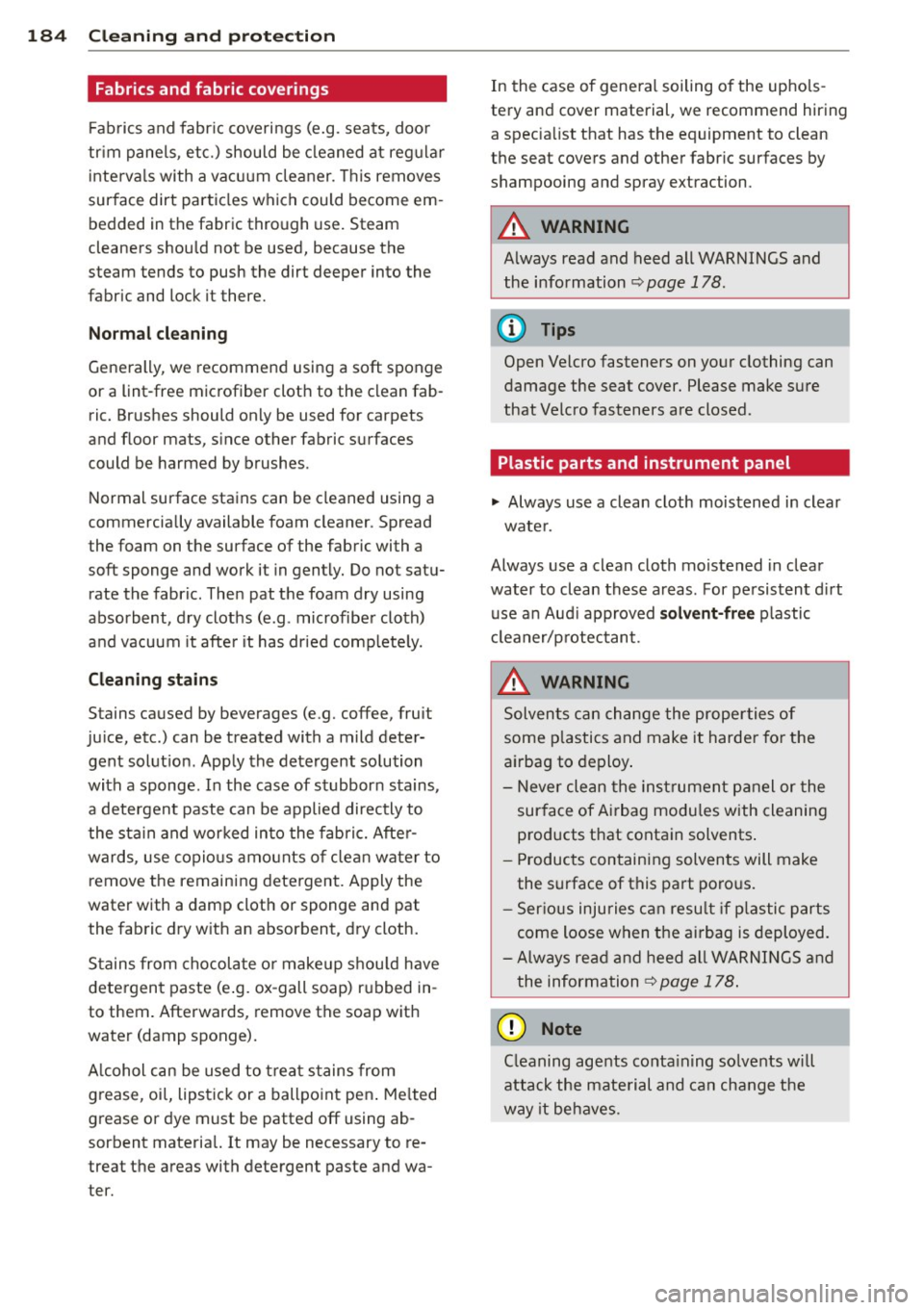
184 Cleaning and protection
Fabrics and fabric coverings
Fab rics and fabr ic coveri ngs (e.g. seats, door
tr im panels, etc.) should be cleaned at reg ular
inte rva ls with a vacuum cleaner. This removes
sur face dirt particles which could become em
bedded in the fabric through use. Steam
cleaners shou ld not be used, because the
steam tends to push the dirt deeper into the
fabric and lock it there.
Normal cleaning
Generally, we recommend using a soft sponge
or a lint-free microfiber cloth to the clean fab
ric. Brushes should on ly be used for carpets
and floor mats, s ince other fabric surfaces
could be harmed by brushes.
Normal surface stains can be cleaned using a
commercially available foam cleaner. Spread
the foam on the surface of the fabric with a
soft sponge and work it in gently. Do not satu
rate the fabric. Then pat the foam d ry using
absorbent, dry cloths (e.g . microfiber cloth)
and vacuum it afte r it has dried comp lete ly.
Cleaning stain s
Stains caused by beverages (e.g. coffee, fruit
ju ice, etc.) can be treated with a mild deter
gent solut ion. App ly the detergent so lution
with a sponge. In the case of stubbor n stains,
a detergent paste can be applied directly to
the sta in and wor ked into the fabric. Afte r
wards, use copio us amo unts o f cle an water to
remove t he remaining dete rgent. Apply the
water with a damp cloth or sponge and pat
the fabric d ry w ith an absorbent, dry cloth.
S tains from chocola te or make up s hou ld have
detergent paste (e .g. ox -gall soap) r ubbed in
to them. Afterwards, remove the soap with
water (damp sponge).
A lcohol can be used to t rea t stains from
g rease, oi l, lips tick or a ballpo in t pen . Me lted
grease or dye must be patted off using ab
sorbent materia l. It may be necessary to re
treat the areas with dete rgent paste and wa
ter. In the case of gene
ra l soiling o f the uphols
tery and cover material, we recommend hiring
a spec ia list that has the equipment to clean
the seat covers and other fabr ic surfaces by
shampooing and spray extraction.
A WARNING '"--
A lways read and heed all WARNINGS and
the information
~ page 178.
(D Tips
Open Ve lcro fasteners on yo ur clothing can
damage the seat cover. Please make sure
that Velcro fasteners are closed.
Plastic parts and instrument panel
~ Always use a clean cloth moistened in clear
wate r.
Always use a clean cloth moistened in clear
water to clean these areas. For pe rsisten t dirt
use an Aud i approved
solvent -free p lastic
cl eaner/p rotec tant.
A WARNING
S olven ts ca n ch ange the prope rties of
some p lastics and make it harde r fo r the
a ir ba g to de ploy .
-
- N ever cle an the in st rument p anel or the
sur face of Ai rbag modu les with cleaning
prod ucts t hat conta in solvents .
- P roduc ts containing solven ts will make
the surface of this part poro us.
- Ser ious inju ries c an resu lt if p lastic parts
come loose when t he ai rbag is deployed.
- Always re ad and heed a ll WAR NIN GS and
t he information¢
page 178 .
(J) Note
Cleaning agents conta ining so lvents w ill
a ttack t he mate rial and can ch ange the
w ay it behaves.
Page 188 of 280
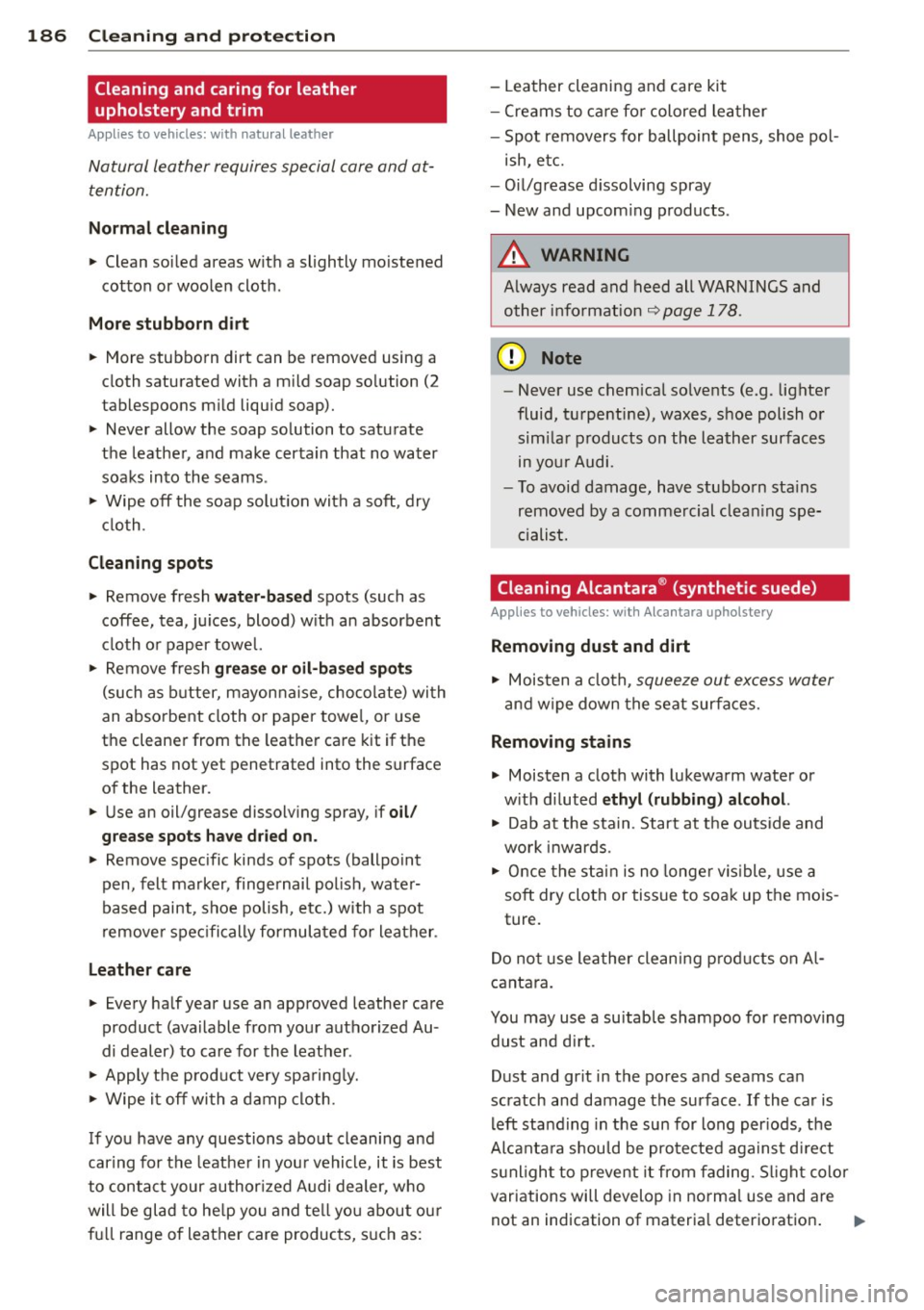
186 Cleaning and protection
Cleaning and caring for leather
upholstery and trim
Applies to vehicles: with natural leather
Natural leather requires special care and at
tention.
Normal cleaning
"' Clean soiled are as with a slightly moi stened
cotton or woolen cloth.
More stubborn dirt
"' More stubborn dirt can be removed us ing a
cloth saturated with a mild soap solution (2
tablespoons mild liquid soap).
"' Never allow the soap solution to saturate
the leather , and make certain that no water
soaks into the seams .
• Wipe off the soap solution with a soft, dry
cloth .
Cleaning spots
"' Remove fresh water-based spots (such as
coffee, tea, juices, blood) with an absorbent
cloth or paper towel.
"' Remove fresh
grease or oil-based spots
(such as butter, mayonnaise , chocolate) with
an absorbent cloth or paper towel, or use
the cleaner from the leather care kit if the
spot has not yet penetrated into the surface
of the leather.
"' Use an oil/grease dissolving spray, if
oil/
grease spots have dried on.
• Remove specific kinds of spots (ballpoint
pen, felt marker, fingernail polish, water
based paint, shoe polish, etc.) with a spot
remover specifically formulated for leather .
Leather care
"' Every half year use an approved leather care
product (available from your authorized Au
di dealer) to care for the leather .
• Apply the product
very sparingly.
• Wipe it off with a damp cloth.
If you have any questions about cleaning and
caring for the leather in your vehicle , it is best
to contact your authorized Audi dealer, who
will be glad to help you and tell you about our
full range of leather care products, such as: -
Leather cleaning and care kit
- Creams to care for colored leather
- Spot
removers for ballpoint pens, shoe pol-
ish, etc.
- Oil/grease dissolving spray
- New and upcoming products .
_&. WARNING
-Always read and heed all WARNINGS and
other information ~
page 178.
(D Note
-Never use chemical solvents (e.g . lighter
fluid, turpentine), waxes, shoe polish or similar products on the leather surfaces
in your Audi .
I
-To avoid damage, have stubborn stains
removed by a commercial cleaning spe
cialist.
Cleaning Alcantara ® (synthetic suede)
Applies to vehicles: with Alcantara upholstery
Removing dust and dirt
• Moisten a cloth , squeeze out excess water
and wipe down the seat surfaces.
Removing stains
"' Moisten a cloth with lukewarm water or
with diluted
ethyl (rubbing) alcohol.
"' Dab at the stain . Start at the outside and
work inwards .
"' Once the stain is no longer visible, use a
soft dry cloth or tissue to soak up the mois
ture.
Do not use leather cleaning products on Al
cantara.
You may use a suitable shampoo for removing dust and dirt.
Dust and grit in the pores and seams can
scratch and damage the surface. If the car is left standing in the sun for long periods, the
Alcantara should be protected against direct
sunlight to prevent it from fading. Slight color
variations will develop in normal use and are
not an indication of material deterioration.
ll-
Page 208 of 280
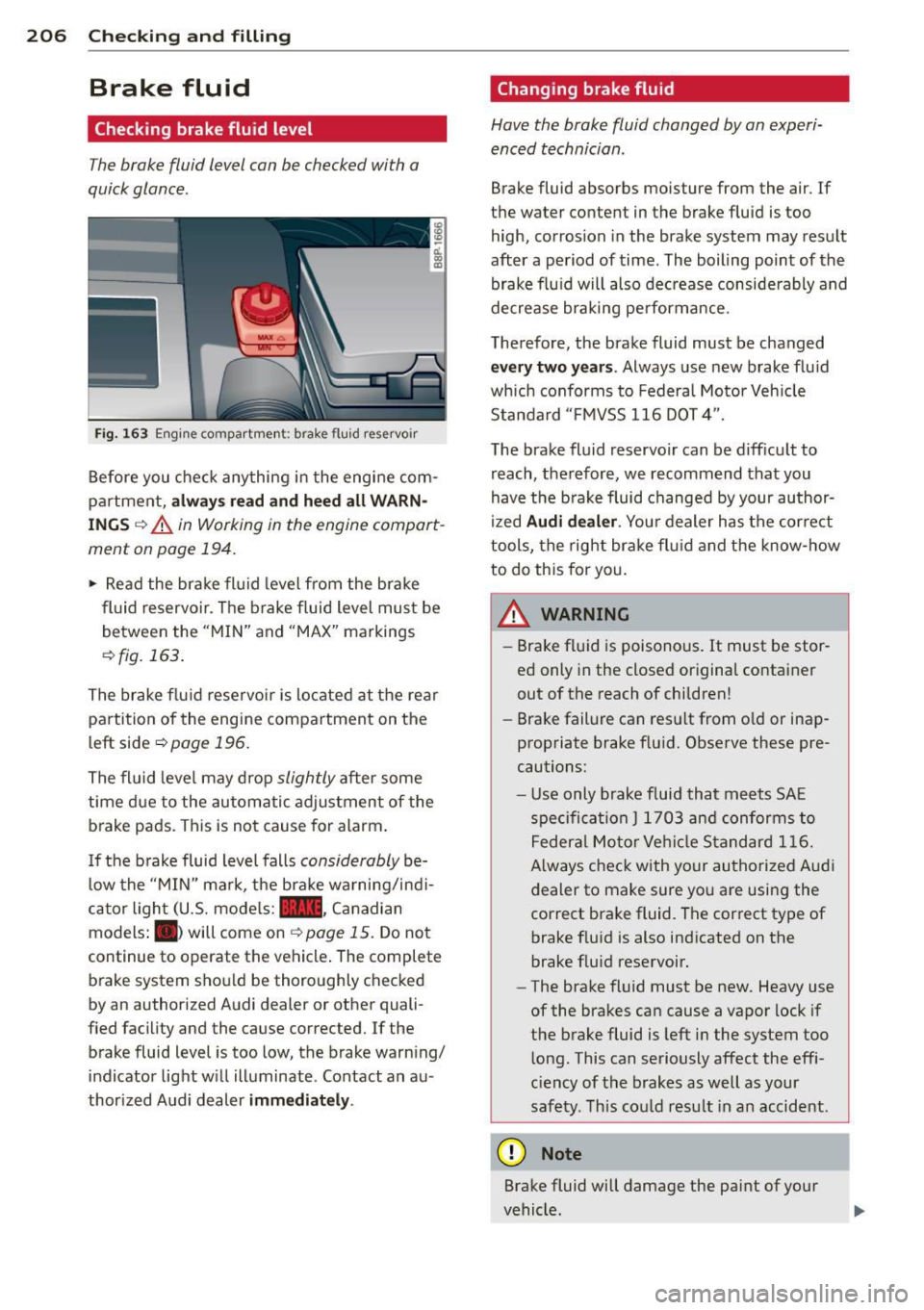
206 Checking and filling
Brake fluid
Checking brake fluid level
The brake fluid level can be checked with a
quick glance .
Fig. 163 Engine compartme nt: brake flu id reservo ir
Before you check anything i n the engine com
partment,
a lwa ys rea d and h eed a ll WA RN·
ING S c:> & in Working in the engine compart
ment on page
194.
~ Read the brake fluid level from the bra ke
fluid reservoir. The brake fluid Level must be
between the "MIN" and "MAX" markings
9fig. 163 .
The brake f lu id rese rvoir is located at the rear
partition of the engine compartment on the
L eft side
¢page 196.
The fluid level may drop slightly after some
time due to the automatic adjustment of the b rake pads . This is not cause for alarm .
I f the b rake fluid Level falls
considerably be
low the "MIN" mark, the brake wa rning/ind i
cator Light (U.S. models:
1111 , Canadian
models:
llllt will come on c:> page 15 . Do not
continue to operate the vehicle . The complete
brake system sho uld be thoroughly checked
by an authorized Audi dealer or other quali
fied facility and the cause corrected. If the
brake fluid level is too low, the brake warn ing/
indicator Light w ill illuminate . Contact an au
thor ized Audi dealer
imm ediatel y.
Changing brake fluid
Have the brake fluid changed by an experi
enced technician .
Brake fluid absorbs moisture from the air. If
the water content in the brake fluid is too high, corrosion in the brake system may result
after a period of time . The boiling point of the
brake flu id will also decrease conside rably and
decrease braking pe rformance.
Therefore, the brake fluid must be changed
eve ry two y ears. Always use new brake flu id
which conforms to Federal Motor Veh icle
Standard "F MVSS 116 DOT 4".
The brake fluid reservoir can be diff icult to
reach, therefore, we recommend that you
have the b rake fluid changed by your author
ized
Audi dealer . Your dealer has the correct
tools, the right brake fl uid and the know -how
to do this for you.
A WARNING
- Brake fluid is poisonous . It must be stor
ed only in the closed original container
out of the reach of children!
- Brake failure can resu lt from o ld or inap
propriate brake flu id. Observe these pre
cautions:
- Use only brake f luid that meets SA E
specifica tion
J 1 7 03 and conforms to
Federa l Moto r Ve hicl e Standard 1 16.
Always check with yo ur authorized Aud i
dealer to make sure yo u are using the
correct brake fluid. The correct type of brake f lu id is also ind icated on the
brake flu id reservoir.
- The brake fluid must be new. Heavy use
of the brakes can cause a vapor lock if
the brake fluid is left in the system too
l ong. This can seriously affect the effi
c iency of the brakes as well as your
safety. This cou ld resu lt in an accident.
(D Note
Brake fluid will damage the paint of your
vehicle .
Page 209 of 280

@ For the sake of the environment
Because of the problem of proper disposal
of brake fluid as we ll as the special tools
req uired and the necessary expert ise, we
recommend that you have the brake fluid
changed by your author ized Audi dealer.
Battery
General information
All work on the battery requires technical
knowledge!
F ig . 1 64 Eng ine co mpa rtment: Batte ry w it h cover*
The battery is located in the engine compart
ment
c::> fig. 164 and is near ly m ain te nance
fre e.
The condition of the battery is checked in the
framework of the inspection.
Disconnecting the battery
The batte ry should not be disconnected. Some
ve hicl e functions such as power windows are
unavailable if the battery termina ls are dis
connected. These funct ions have to be re
l earned after the battery term inals are con
nected aga in. To prevent this, the battery
should only be disconnected from the vehicle
electrical system if absolutely necessary .
Function
Power window
one-touch up/
down function
Master key with
remote control
Reprogramming
c::, page 45, Reactivating
the system after battery
disconnection
Synchronization
~page 38
Checkin g and fillin g 207
Reprogramming
Digita l clock c::, page 11
ESP indicator light The indicator ligh t goes
out after driving a few
meters
Vehicl es not driven for long periods and
sho rt -d is tance op eration
If you do no t drive your vehicle for several
days or weeks, electrical consumers are grad
u ally scaled back or switched off . This reduces
energy use and ensures the vehicle will be
able to start after long periods of time
c::, page 167. Some convenience functions
such as opening w it h the remote control key
may not be available. These conve nience func
tions wi ll be available again once you switch
the ignit io n on and sta rt the engine. Even
whe n consume rs a re switched off, the battery
will become deeply discharged by stand -by
power consumers if the vehicle is not driven
for several months . Deep discharging results
in a chemical reaction that destroys the inside
of the battery. The battery must be charged
every month to prevent th is
c::, page 209. Do
not disconnect the battery or the anti-t heft
alarm system* will not work .
Winter operation
Cold weather places higher demands on the
battery. This results in reduced starting abili
ty. Have the battery checked and recharged if
necessary befo re the cold weather begins.
Avoid unnecessary power consumpt ion, par
ticularly in city traffic or when traveling only
short distances . Let your authorized Audi
dealer check the capacity of the vehicle bat
tery before winter sets in
c::, page 209 . A well
c harged bat tery will not o nly prevent s tarti ng
problems when the weather is cold, but will
also last longer .
(D Note
-All wo rk on the batte ry requ ires techn i
cal know le d ge. P lease con ta ct an Audi
dealership or another authorized fa cility
lill>